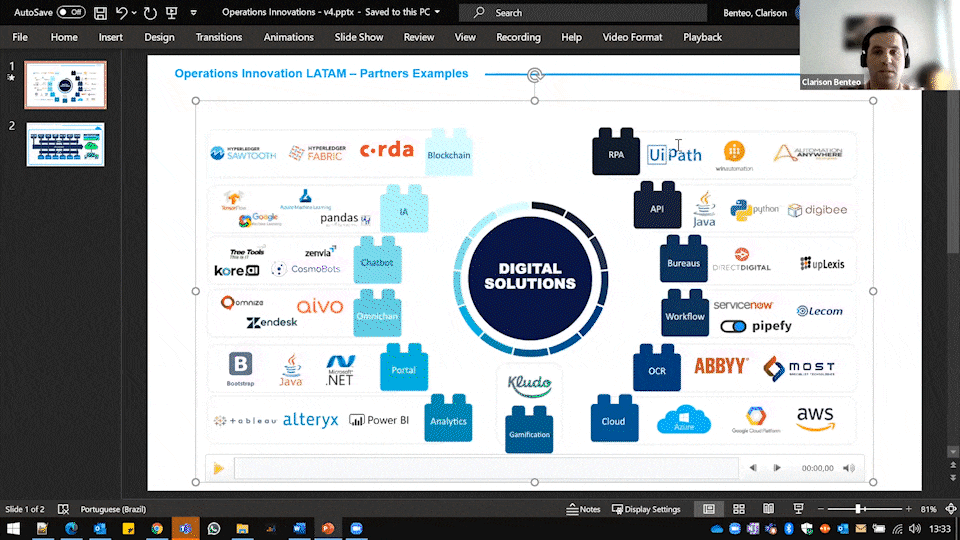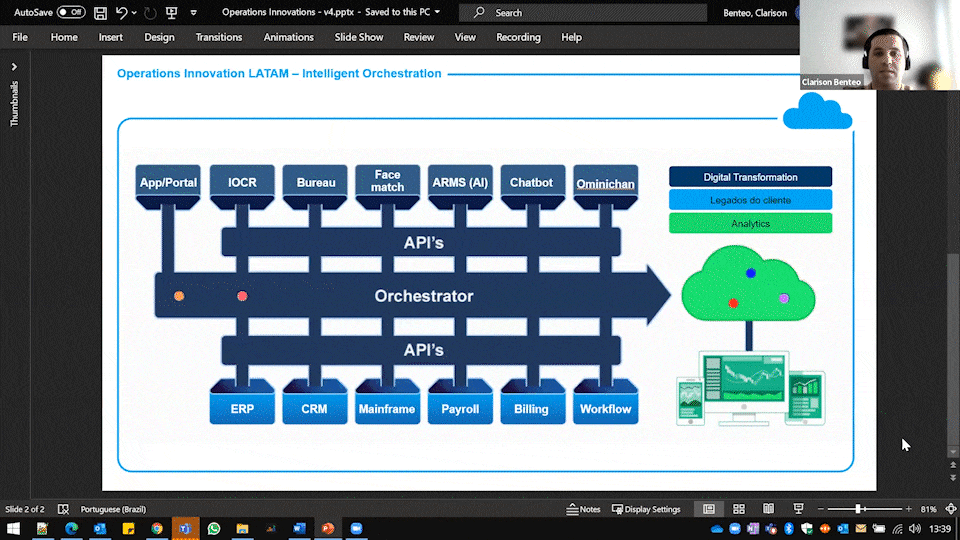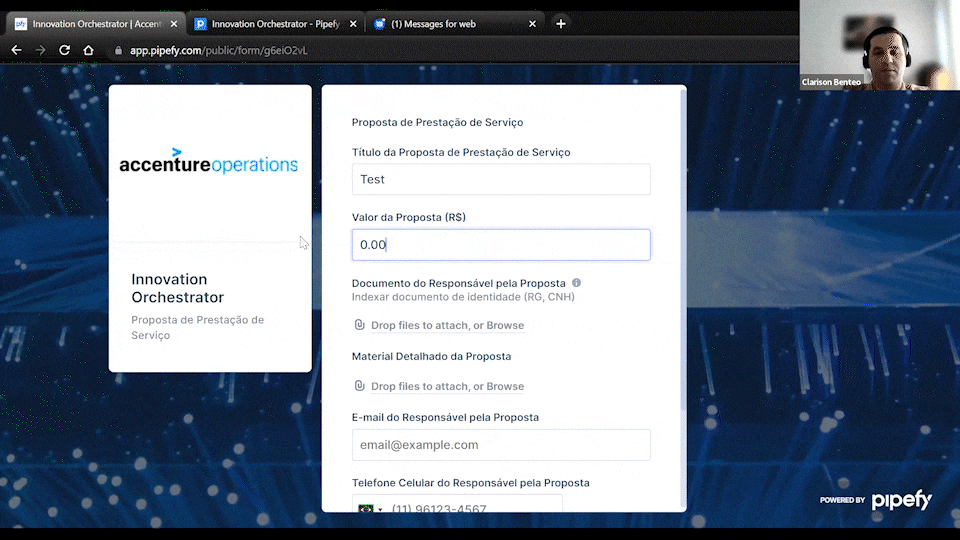ARTICLE SUMMARY
Learn how Accenture, a leading IT company, uses Pipefy’s low-code software as the backbone of their client’s digital business innovation and transformation.

Accenture is known for innovating creative solutions. In this webinar, digital transformation experts from Accenture discussed what happened when they turned those same creative methods inward, and how low-code technology provided them the agility and flexibility to standardize processes and achieve their own digital transformation.
Hosted by Kristen Davis, Product Evangelist at Pipefy, the interview-style panel discussion featured key insights from:
- Fabiano Guastella, Digital Innovation Associate Director at Accenture
- Clarison Benteo, Digital Transformation Manager at Accenture
- Felipe Carvalho, Sales and CS Leader at Pipefy
Below is a recap of the discussion, including how digital transformation is shaping the future of work, emerging trends for digital-first teams, and how Pipefy’s low-code automation software helped Accenture gain the flexibility and agility to scale end-to-end process solutions for its clients.
Why the future of work is low-code
1. Low-code technology is cost-effective
For workers, the pandemic sped up digital transformation efforts to communicate and stay connected digitally. For businesses, the pandemic pushed them another step forward in their digital transformation in a cost-effective and empowered way.
“Before the pandemic, digital transformation was already a large priority for our clients, but it was a lower priority and more conservative,” said Guastella. But as the world grew to be more digitized, digital transformation became essential – and so did the adoption of low-code technology.
Low-code automation allows teams to do more with less and can be very cost-effective, a major draw for business teams. “Low-code is helping with digital transformation because it saves development costs and shortens development time,” Guastella says.
Business units need agility. IT needs control. See how no- No-Code Automation: Good for Business, Great for IT
2. Low-code builds alignment between IT teams and business units
Historically, resistance to change was a bottleneck for digital transformation, manifesting itself as a lack of adaptability and a deficit of tech skills. A top-down approach to tech implementation can eventually lead to adoption issues and possible security risks related to shadow IT or lack of standardization.
But as the need for digital transformation increases, the real question now is: How can businesses empower non-technical employees to develop and deploy solutions at their own pace?
“When a model where tech adoption is top-down is flipped, the volume of tech being adopted explodes,” Carvalho says. “Low-code and no-code addresses those challenges. Digital transformation is moving away from being IT-dependence and adjusting to the needs of businesses and speed.”
We plug additional blocks with Pipefy through API through RPAs to give clients a complete end-to-end solution that is 100% customizable with efficient technology within small timelines.
Clarison Benteo, Digital Transformation Manager at Accenture
Trends and challenges for digital-first teams
Adopting low-code/no-code to balance IT priorities and empower business areas
One driver behind the adoption of low-code/no-code tools is the scarcity in tech talent and how its impact on deploying technology is highly dependent on IT. “We’re seeing other factors like business areas wanting to move faster and faster,” Carvalho says. “We’re also seeing an overall trend where people want to solve things on their own. They don’t want to depend on others,”
Today, companies see low-code automation as a solution for IT teams that may not have the capacity to prioritize subprocess optimizations or building solutions for long-tail processes that don’t align with their own team’s priorities.
This adoption also leads to additional benefits like cost reduction, projects moving faster, and empowering business areas to solve things on their own while some of those IT resources can then be reallocated to more complex projects where IT is needed.
Long-tail processes are unique subprocesses and workflows that teams need but aren’t being addressed by existing apps and software. These “incidental” processes are commonly not anticipated, and, when they go unresolved, they can lead to larger problems — both for the business and IT.
Concerns over governance and security
As more business teams are empowered to undertake some process optimizations themselves, the question for many companies is: how do we allow people to move fast while enforcing security requirements and maintaining visibility?
“There’s concern over the frameworks used internally to define when IT should be involved, when IT should allow business areas to move on their own, and what is the decision process when we’re looking at complexity and risk? Also, how to control what is being done and ensure that organizations and important data are secure,” Carvalho says.
The importance of organizational buy-in
“It’s important to mention that digital transformation is a journey that also includes changing the culture of a company, pushing employees to leave their comfort zones, implementing changes, and even changing customer relationships and the types of service or products being offered,” Guastella says.
“But digital transformation isn’t just about technology. It’s about the appetite for investment and the pursuit of this shift to digital, so sponsorship for this change and the investment is very important.”
How Pipefy helped Accenture’s digital transformation
Accelerated time-to-market
With Pipefy as the low-code platform, Accenture’s digital transformation team is able to accelerate time-to-market. “What we provide to our customers is a modularized solution, like building blocks, with Pipefy’s low-code platform,” said Benteo. “We have Pipefy working as a workflow orchestrator. We plug additional blocks with Pipefy through API through RPAs to give clients a complete end-to-end solution that is 100% customizable with efficient technology within small timelines. This is what we do when we are doing digital transformations for our customers.”
Improved customer experience and services
Benteo explains that digital solutions are like building blocks, which they collect and use to connect end-to-end processes. Pipefy works as a workflow and orchestrator tool that can be connected to legacy systems and additional technologies.
With Pipefy’s low-code software as the bridge or backbone connecting legacy systems, automation, and manual operations, Accenture is able to provide customers with the solutions they need. “If a customer needs an additional solution, we would integrate that with other blocks to Pipefy to give the customer the solution they requested,” Benteo says.

Optimized end-to-end processes by centralizing, orchestrating, and routing data through legacy systems
As an intelligent orchestration tool, Pipefy concentrates all the data and provides the customer with a visualization of valuable process information. Here’s an example of what intelligent orchestration looks like when fully integrated with legacy systems via APIs gateways, the heart of digital transformation:

Low-code automation and integrations eliminated manual work and improved collaboration
Below are two demos showcasing how Pipefy’s automation capabilities and customizable smart form streamlines previously manual work.
Demo 1: Documents and images can be attached directly to the intake form. To reduce delays, conditions can be added to ensure that required information is submitted each time. For external stakeholders, the request tracking feature is great for status updates.

Demo 2: The information and attachments submitted automatically populate within the connect process as a card. With Kanban view, teams can get a high-level overview of requests/tasks submitted and the phase they are in within the process.
Once the card is received, Benteo opens and reviews the card. “The operator is going to see if all the documents are OK. If they are, they would select “OK” and you can see in the activity section that some automations are automatically running and moving the task to the next step.”

“All these steps were previously manual, and now they’re automated,” Guastella says. By customizing this process further and integrating existing systems into Pipefy, data becomes more centralized, visibility is improved, and the burden of manual work is resolved.
“For integrations, we mainly use APIs. API gateways are very important and are the heart of digital transformation because APIs take less to sustain unlike RPAs,” Guastella adds. “With RPAs, you need a lot of people to monitor how the RPAs are running.” Pipefy’s easily customizable low-code platform eliminated that problem.
Advice for leading digital transformation and low-code initiatives
For companies with low maturity (and even for some with high maturity), it may seem like an uphill battle to take on such a large organizational change – but it’s not impossible. To get started, Guastella suggest taking these three steps:
- Find out what’s working (and what isn’t). In order to get started, it’s important to “understand the as-is process, as-is department, or as-is project you want to transform,” said Guastella.
- Identify a champion. Once teams have a full understanding of how things are working, then can they bring in key leaders and decision-makers — like C-suite and HR leaders — as champions for the transformation. This type of buy-in is essential to creating a sense of co-innovation, making what once felt like an impossible transformation into a possible initiative.
- Build in waves. While technology is a major part of digital transformation, it’s much more than that. “It’s an environment. It’s a journey. And depending on the level of maturity, digital transformation can start in waves,” said Guastella. For example, the first wave can be integrating workflow solutions with legacy systems, the second wave can be implementing score and rules engines, and then the third wave can be artificial intelligence and an analytics hub. “For our clients, we can either implement everything in one wave, or we can continuously improve with a lot of waves.”
While a high degree of business maturity is beneficial, leading initiatives really comes down to having an appetite for investment, starting “small,” and building toward a full digital transformation.
ICYMI: Low-code webinar series recaps and digital transformation insights
Unable to attend previous webinars? Don’t miss out on industry-leading conversations and insights. Check out our previous low-code webinar series recaps to keep informed:
Why Low-Code Is Key to Digital Transformation, featuring guest speaker Carlos Cima, Vice President of Technology at SoftBank Group International
How IBM and Pipefy Navigate the Digital Landscape With Low-Code Solutions, featuring guest speaker Guilherme Novaes, Ecosystem Director at IBM Brasil
*Some comments and quotes have been edited for clarity.










